Shiva Rudram is a sacred Vedic chant from the Yajur Veda, invoking Lord Shiva’s blessings for peace, prosperity, and spiritual growth. Its verses, available in PDF formats, are widely revered for their profound spiritual significance and calming effects on the mind, making it a cornerstone of Hindu devotion and meditation practices.
What is Shiva Rudram?
Shiva Rudram, a sacred Vedic chant from the Yajur Veda, is a powerful invocation of Lord Shiva, seeking his blessings for peace, prosperity, and spiritual growth. It is structured into 11 Anuvakas, or sections, and is divided into Namakam (adoration) and Chamakam (aspirations). This chant is renowned for its ability to purify the mind, bestow divine grace, and fulfill desires. Available in PDF formats, it is a widely accessed resource for devotees, offering detailed hymns and mantras that glorify Shiva’s divine attributes. Shiva Rudram is a cornerstone of Hindu spirituality, used in rituals and personal worship to connect with the divine and attain inner harmony.
Significance of Shiva Rudram in Hindu Scriptures
Shiva Rudram holds immense significance in Hindu scriptures as a powerful hymn from the Yajur Veda, glorifying Lord Shiva. It is considered a means to attain spiritual enlightenment and inner peace. The chant is revered for its ability to purify the mind, ward off negativity, and invoke divine blessings. Its structure, divided into Namakam and Chamakam, symbolizes devotion and aspirations, making it a central part of rituals and worship. Available in PDF formats, Shiva Rudram is accessible to devotees worldwide, preserving its Vedic heritage and allowing its timeless wisdom to inspire spiritual growth and harmony.
Overview of the Structure of Shiva Rudram
Shiva Rudram is structured as a hymn from the Yajur Veda, divided into two main sections: Namakam and Chamakam. Namakam glorifies Lord Shiva’s divine attributes, while Chamakam expresses devotion and seeks blessings. The Rudram consists of 11 Anuvakas, each with specific chants and rhythms. These verses are carefully arranged to evoke spiritual connection and harmony. The structure emphasizes both devotion and aspiration, making it a comprehensive prayer. Available in PDF formats, Shiva Rudram’s layout is easily accessible, allowing devotees to study and chant its verses with clarity and precision, ensuring its Vedic essence is preserved for modern practitioners.
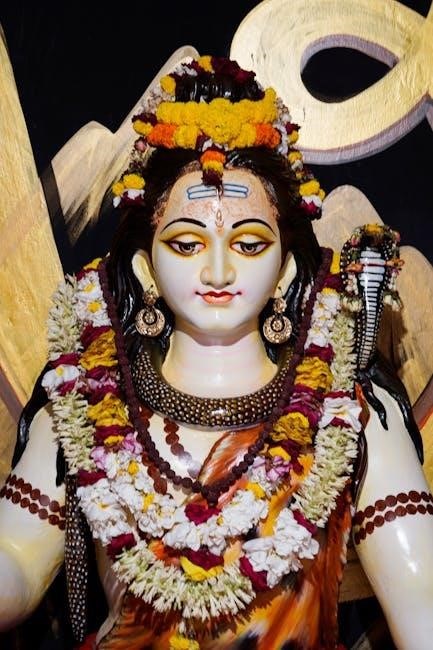
Vedic Background of Shiva Rudram
Shiva Rudram originates from the Yajur Veda, an ancient Vedic text. It is a powerful invocation of Lord Shiva, highlighting His divine attributes and cosmic influence, available in PDF formats for modern accessibility and study.
Shiva Rudram as Part of the Yajur Veda
Shiva Rudram is an integral section of the Yajur Veda, one of the four sacred Vedas in Hinduism. It is divided into two main parts: the Namakam, which praises Lord Shiva, and the Chamakam, which describes His divine attributes and cosmic influence. The Rudram consists of 11 Anuvakas, or verses, that invoke Shiva’s blessings for prosperity, peace, and spiritual growth. As part of the Yajur Veda, it is considered a powerful Vedic hymn that has been passed down through generations. Today, Shiva Rudram is widely available in PDF formats, making it accessible for devotees to study, chant, and connect with Shiva’s divine energy.
Origins and Composition of the Rudram
The Shiva Rudram is an ancient Vedic hymn rooted in the Yajur Veda, with its origins tracing back to revered Rishis who composed it to glorify Lord Shiva. The Rudram is structured into 11 Anuvakas, or sections, each containing powerful mantras that invoke Shiva’s blessings. It is divided into the Namakam, which praises Shiva, and the Chamakam, which highlights His divine attributes. The composition reflects deep spiritual insights and poetic devotion, emphasizing Shiva’s role as both destroyer and benefactor. Today, the Rudram is widely studied and chanted, with its text readily available in PDF formats, making it accessible for spiritual seekers and scholars alike to explore its profound significance.
The Role of Rishis in Shaping the Rudram
The Rishis, ancient Vedic seers, played a pivotal role in composing and structuring the Shiva Rudram, infusing it with profound spiritual wisdom. Their deep meditation and divine inspiration led to the creation of its hymns, which glorify Lord Shiva’s attributes and powers. The Rishis ensured the Rudram’s verses were both devotionally rich and philosophically profound, making it a cornerstone of Vedic chanting. Their contributions have preserved the hymn’s integrity over centuries, allowing it to be passed down through generations. Today, their work is accessible in Shiva Rudram PDF formats, enabling global seekers to connect with its timeless spirituality and experience its transformative power in their lives.
Structure and Content of Shiva Rudram
Shiva Rudram is structured into Namakam and Chamakam, with 11 Anuvakas, offering praises and supplications to Lord Shiva. Its verses, available in PDF, detail divine attributes and rituals.
Divisions of Shiva Rudram: Namakam and Chamakam
Shiva Rudram is divided into two main sections: Namakam and Chamakam. Namakam comprises 11 verses, glorifying Shiva as the supreme being, while Chamakam requests divine blessings for prosperity and protection. Together, they form a complete worship, reflecting devotion and spiritual aspirations. Available in PDF formats, these chants are chanted in temples and homes, offering solace and spiritual growth. The structure emphasizes the divine attributes of Shiva, making it a powerful Vedic hymn for seekers of peace and enlightenment.
11 Anuvakas of Shiva Rudram Explained
The Shiva Rudram consists of 11 Anuvakas, each serving as a devotional hymn to Lord Shiva. These verses are structured to invoke His blessings and describe His divine attributes. The Anuvakas are divided into Namakam and Chamakam, with each section having specific spiritual significance. They glorify Shiva’s power, compassion, and cosmic role. The 11 Anuvakas are chanted to seek forgiveness, prosperity, and liberation. Available in PDF formats, they provide a structured approach for devotees to connect with Shiva, ensuring a meaningful and transformative spiritual experience. Each Anuvaka is a powerful invocation, deeply rooted in Vedic tradition, offering solace and enlightenment to those who chant them with devotion.
Key Mantras and Their Meanings
The Shiva Rudram contains powerful mantras that hold deep spiritual significance. The Namakam and Chamakam sections include verses like “Namaste Rudra Manyava” and “Shaantih Shaantih Shaantih,” which invoke Shiva’s blessings for peace and prosperity. These mantras glorify Shiva’s cosmic attributes, such as His role as the destroyer of negativity and the granter of liberation. The chants also include prayers for forgiveness and protection, emphasizing Shiva’s compassionate nature. Each mantra is designed to connect the chanter with the divine, fostering spiritual growth and inner harmony. Available in PDF guides, these mantras are recited to seek Shiva’s grace and attain a balanced life. Their meanings highlight the essence of devotion and surrender.
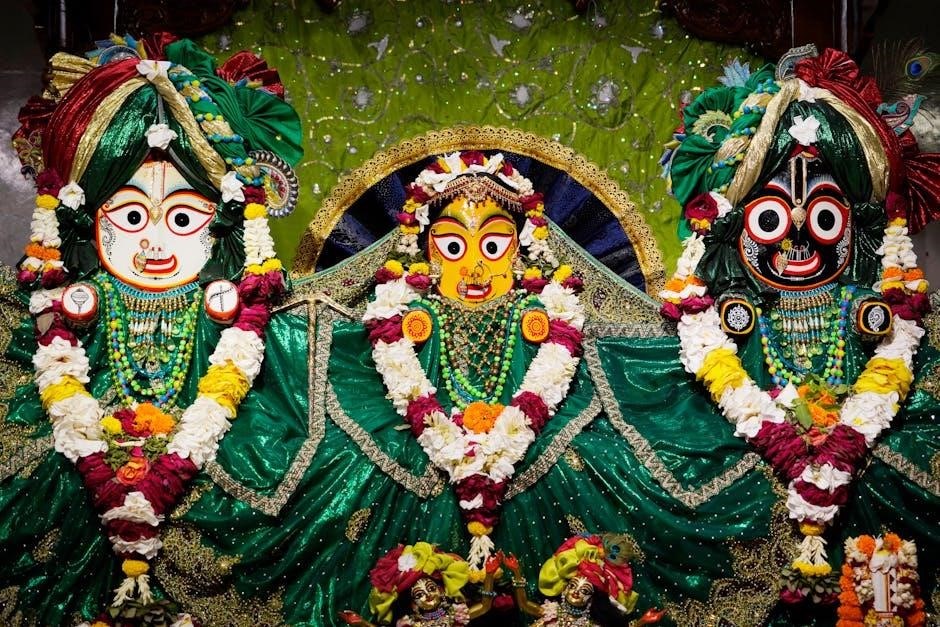
Significance of Shiva Rudram
Shiva Rudram is a powerful Vedic hymn that signifies spiritual growth, mind calming, and material benefits. Its chants glorify Lord Shiva, offering divine protection and liberation, fostering inner peace and prosperity.
Spiritual Growth Through Chanting Rudram
Chanting Shiva Rudram fosters profound spiritual growth by purifying the mind and soul. It helps devotees connect deeply with Lord Shiva, fostering a sense of divine consciousness and inner harmony. The recitation of Rudram’s verses, especially the 11 Anuvakas, symbolizes completeness and spiritual fulfillment. Regular chanting enhances self-realization, allowing individuals to transcend worldly attachments and seek liberation. The rhythmic vibrations of the mantras create a meditative state, aligning the practitioner with universal energy. This practice is believed to cleanse past karmas and bestow spiritual enlightenment, making it a vital tool for seekers of divine truth and self-realization.
Rudram as a Means to Calm the Mind
Chanting Shiva Rudram is a powerful practice for calming the mind and achieving inner peace. The rhythmic vibrations of its mantras create a soothing effect, helping to quiet mental chatter and reduce stress. Regular recitation fosters emotional stability and clarity, allowing individuals to navigate life’s challenges with greater ease. The repetitive nature of the chants induces a meditative state, promoting relaxation and focus. By immersing oneself in the divine energy of Rudram, one can experience profound tranquility and mental clarity. This ancient Vedic chant is widely recognized for its ability to harmonize the mind, body, and soul, making it an essential tool for mental well-being in today’s fast-paced world.
Material Benefits of Chanting Shiva Rudram
Chanting Shiva Rudram is believed to bring numerous material benefits, including prosperity, health, and the fulfillment of desires. The powerful vibrations of its mantras are thought to ward off obstacles and negative energies, creating an auspicious environment for success. Many devotees believe that reciting Rudram with sincerity can lead to financial stability, improved relationships, and overall well-being. It is also considered a means to seek divine intervention for solving life’s challenges. The chant’s ability to align one’s energies with universal harmony is said to attract positive outcomes, making it a popular practice for those seeking both spiritual and material enrichment. Its cultural significance further emphasizes its role in granting tangible benefits to those who chant it with faith and dedication.

Chanting Shiva Rudram: Guidelines and Practices
Chanting Shiva Rudram requires proper pronunciation, concentration, and devotion. It is ideal to chant during early mornings or sacred rituals, ensuring faith and discipline for optimal benefits.
How to Chant Shiva Rudram Correctly
To chant Shiva Rudram correctly, one must ensure proper pronunciation and devotion. Begin by obtaining a Shiva Rudram PDF for accurate text and guidelines. Chanting ideally occurs during early mornings or sacred rituals, maintaining focus and purity of intent. Practice pronunciation carefully, as errors may reduce its spiritual impact. Start with the Namakam section, followed by Chamakam, ensuring rhythm and tone align with Vedic traditions. Seek guidance from experienced gurus or online resources to master the chant. Regular practice enhances spiritual connection and mindfulness, fulfilling the purpose of this sacred Vedic hymn dedicated to Lord Shiva.
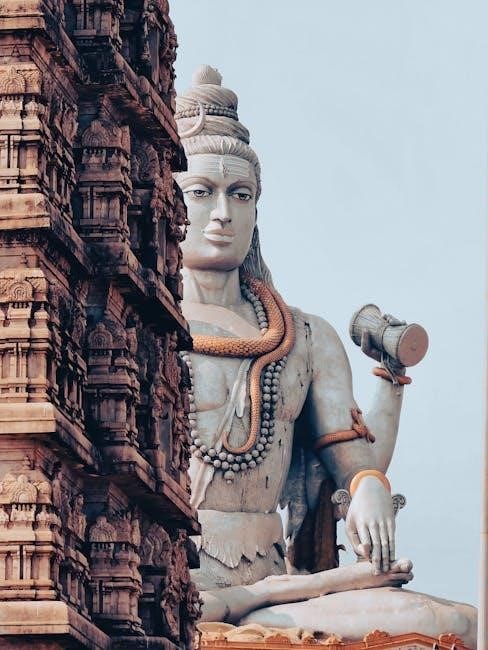
The Role of Devotion in Rudram Chanting
Devotion plays a pivotal role in Rudram chanting, as it bridges the chanter with the divine essence of Lord Shiva. A sincere and dedicated heart amplifies the spiritual benefits of the chant, fostering inner peace and connection. Available guides in Shiva Rudram PDF emphasize that true devotion transcends mere mechanical recitation, requiring mindfulness and emotional engagement. Chanters are encouraged to visualize Shiva’s attributes while reciting, deepening their devotion. This heartfelt approach not only enhances personal spiritual growth but also aligns with the Vedic intent of the Rudram, making the practice a powerful tool for seekers of divine grace and self-realization.
Best Times for Chanting Shiva Rudram
The optimal times for chanting Shiva Rudram are during the early morning hours, known as Brahma Muhurta, and on Mondays, which are particularly sacred for Lord Shiva. Chanting during solar or lunar eclipses is also considered highly auspicious, as it amplifies the spiritual benefits. Additionally, performing the chant on significant days like Maha Shivaratri or during the Pradosha time (dusk) is deeply revered. Regular chanting, regardless of the time, fosters consistency and devotion. Resources like Shiva Rudram PDF provide insights into these timings, emphasizing the importance of a dedicated and peaceful mindset for a profound spiritual experience.

Types of Rudram Recitations
Shiva Rudram recitations vary, with Laghu Rudra being the simplified version and Maha Rudra the extended form. Ekadasa Rudra involves chanting Rudram eleven times, while Ati Rudra is the most intensive, performed for profound spiritual outcomes.
Laghu Rudra: A Simplified Version
Laghu Rudra, or the “Small Rudra,” is a condensed version of the Shiva Rudram chant, designed for easier recitation while retaining its spiritual essence. It typically involves chanting the Namakam and Chamakam sections, along with specific verses from the Yajur Veda. This format is ideal for devotees seeking a shorter yet impactful way to worship Lord Shiva.
The Laghu Rudra is often performed during pujas and rituals, offering a accessible method for spiritual growth and mental peace. Its simplicity makes it a popular choice for those new to Vedic chanting, ensuring that Shiva’s blessings are attainable for all.
Maha Rudra: The Extended Version
Maha Rudra, or the “Great Rudra,” is an elaborate version of the Shiva Rudram chant, involving the recitation of the Rudram 11 times, known as Ekadasa Rudra. This extended ritual is typically performed during significant spiritual or religious events, requiring extensive preparation and time. It is considered highly auspicious and is often conducted by experienced priests or devotees.
The Maha Rudra is believed to purify the environment, bring prosperity, and offer deep spiritual growth. Its detailed structure includes multiple rounds of chanting, making it a powerful and transformative experience for those who participate. This version is ideal for those seeking a profound connection with Lord Shiva and his divine energy.
Ekadasa Rudra: Chanting Rudram 11 Times
Ekadasa Rudra involves chanting the Shiva Rudram 11 times, a practice deeply rooted in Vedic tradition. This elaborate ritual is often performed during significant spiritual events or to seek divine blessings. Each recitation is believed to amplify the spiritual benefits, offering profound purification and connection with Lord Shiva.
The process includes meticulous preparation and is typically led by experienced priests. Devotees believe that chanting Rudram 11 times invokes Shiva’s grace, ensuring prosperity and spiritual growth. This practice is considered a powerful means to attain inner peace and divine harmony, making it a cherished tradition among followers of Shiva.
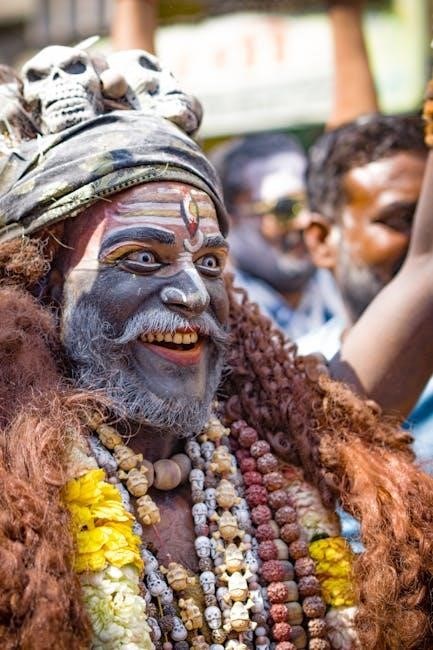
Rituals Involving Shiva Rudram
Shiva Rudram is integral to various rituals, often performed with sacred offerings and Vedic chants. Its PDF versions guide devotees in proper recitation during ceremonies like Rudra Path.
Rudra Path: A Detailed Ritual
Rudra Path is an elaborate ritual involving the chanting of Shiva Rudram, typically performed in temples or during special occasions. It includes the recitation of Namakam and Chamakam, along with additional Vedic hymns. The ritual is often conducted by trained priests, following precise Vedic traditions. Rudra Path is considered an extended version of Rudram chanting, often performed 11 times, known as Ekadasa Rudra. This ritual is believed to invoke Lord Shiva’s blessings, ensuring spiritual cleansing and material prosperity. Devotees participate by offering flowers, fruits, and sacred offerings, creating a divine atmosphere. The detailed process is guided by PDF resources available online, making it accessible for those seeking to perform the ritual authentically.
Shiva Rudram in Temple Worship
Shiva Rudram holds a revered place in temple worship, often chanted during sacred rituals and festivals. Priests and devotees recite the Namakam and Chamakam sections, accompanied by offerings to Lord Shiva. Temples worldwide incorporate Rudram chanting in daily or special poojas, seeking divine blessings. The chanting is believed to purify the environment and bestow spiritual and material benefits. Many temples provide Shiva Rudram PDFs for devotees to follow the hymns accurately, ensuring authenticity. This practice strengthens the connection between the divine and the devotee, fostering a sense of community and devotion. The ritual is a testament to the enduring significance of Vedic chants in temple traditions.
Ati Rudram: The Ultimate Ritual
Ati Rudram is the most intensive and elevated form of Shiva Rudram chanting, considered the pinnacle of devotion. It involves reciting the Rudram 11 times, followed by the Chamakam 11 times, and concludes with the Purusha Sooktam and Narayana Sooktam. This ritual is performed to seek Lord Shiva’s ultimate blessings and is often conducted during significant spiritual events or as a grand offering. Devotees believe it grants profound spiritual growth and fulfillment of desires. The Ati Rudram is typically performed by experienced priests and requires strict adherence to Vedic traditions. Its grandeur and spiritual potency make it a revered practice among Shiva devotees worldwide, often documented in Shiva Rudram PDFs for guidance.
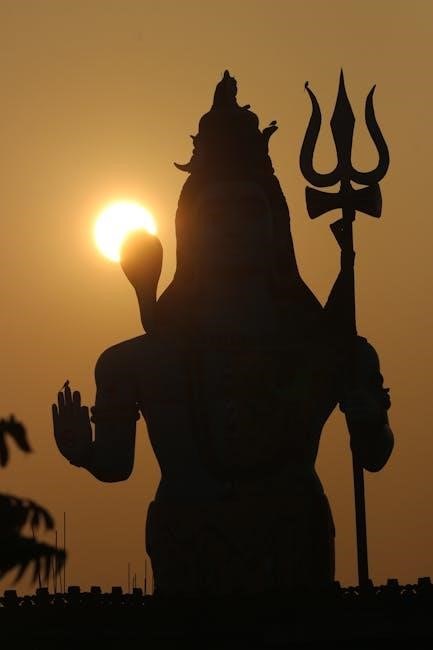
Shiva Rudram and Its Cultural Impact
Shiva Rudram has deeply influenced modern spirituality, fostering global devotion and cultural exchange. Its chanting is widely popular, featured in Indian festivals and inspiring spiritual practices worldwide.
Shiva Rudram in Modern Spirituality
Shiva Rudram has become a cornerstone of modern spirituality, offering a bridge between ancient Vedic traditions and contemporary practices. Many seekers worldwide incorporate its chanting into meditation and yoga routines, finding solace in its rhythmic verses. The availability of Rudram PDFs online has made it accessible to a global audience, allowing individuals to explore its spiritual depth. This chant is often used in workshops and retreats to promote inner peace and self-discovery. Its universal appeal lies in its ability to transcend cultural boundaries, making it a powerful tool for spiritual growth in today’s fast-paced world.

Popularity of Rudram Chanting Worldwide
Shiva Rudram chanting has gained global recognition, resonating with diverse cultures and spiritual seekers. Its universal appeal lies in its ability to evoke peace and connect individuals with divine energy. The availability of Rudram PDFs online has facilitated its spread, making it accessible to millions worldwide. Spiritual retreats, yoga workshops, and cultural festivals now frequently incorporate Rudram chanting, attracting both devout followers and curious newcomers. Its rhythmic verses and profound meanings transcend linguistic barriers, fostering a sense of unity and shared spiritual growth. This ancient Vedic chant continues to inspire people globally, bridging tradition with modern spirituality and enriching lives through its timeless essence.
Shiva Rudram in Indian Culture and Festivals
Shiva Rudram holds a revered place in Indian culture, deeply embedded in spiritual and festive traditions. During Maha Shivaratri, devotees chant Rudram to honor Lord Shiva, seeking blessings and spiritual enlightenment. In temples, priests recite Rudram during special pujas, creating an atmosphere of divine connection. Cultural festivals often feature Rudram chanting, blending spirituality with communal celebration. Its verses resonate in classical dance performances, such as Bharatanatyam, showcasing its artistic significance. Rudram PDFs are widely distributed during these events, enabling participation and fostering a sense of unity. This ancient chant continues to inspire and enrich Indian culture, bridging the gap between tradition and modern celebrations, ensuring its timeless relevance in society.
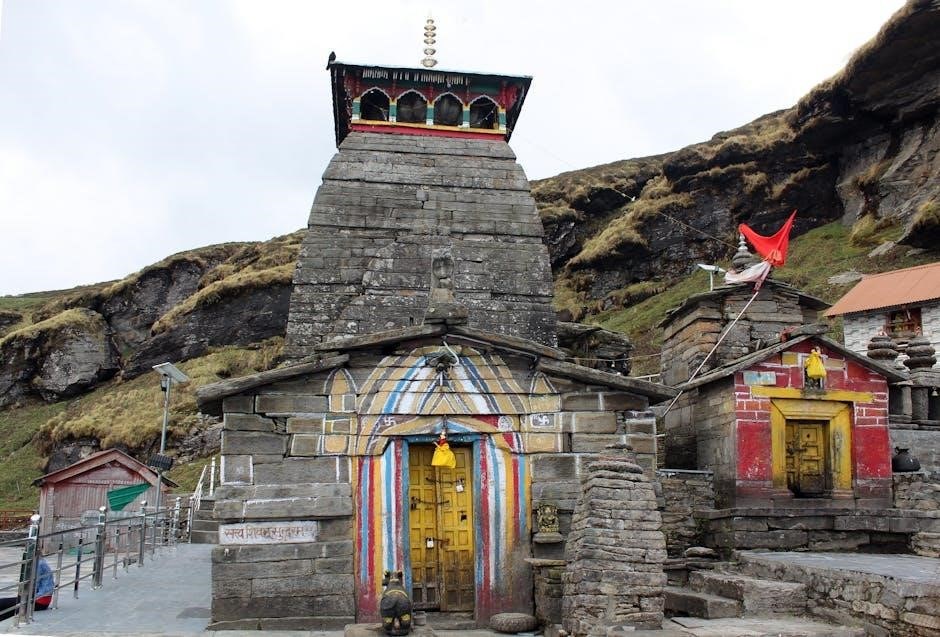
Resources for Shiva Rudram
Shiva Rudram PDFs are widely available online, offering detailed chants and interpretations. Google Books and Scribd provide accessible versions. Online platforms like YouTube and Vedic Pathshala offer tutorials. Books and scriptures on Rudram are invaluable for deeper study, ensuring its preservation and practice.
Shiva Rudram PDF: Sources and Availability
Shiva Rudram PDFs are readily available online, offering convenient access to the sacred chants. Platforms like Google Books, Scribd, and Vedic Pathshala provide downloadable versions. These PDFs often include the Namakam, Chamakam, and additional hymns, along with translations and interpretations. Many websites dedicated to Hindu scriptures and Vedic studies host these files for free. Additionally, religious organizations and temples share PDF resources for devotees. The PDFs are often formatted for easy reading and chanting, making them accessible to both beginners and advanced practitioners. This widespread availability ensures that the spiritual benefits of Shiva Rudram reach a global audience, preserving its ancient significance.
Online Platforms for Learning Rudram
Online platforms offer extensive resources for learning Shiva Rudram, catering to both beginners and advanced practitioners. Websites like YouTube, Vedantu, and Vedic Pathshala provide video tutorials, guided chants, and interactive lessons. Apps such as Dhyan and LearnVedas offer structured courses and audio recordings. Additionally, platforms like Google Books and Scribd host downloadable PDFs and e-books with detailed explanations. These resources ensure easy access to authentic teachings, helping learners master pronunciation, rhythm, and the spiritual essence of Rudram. They also provide opportunities to connect with gurus and like-minded devotees, fostering a community-driven learning experience.
Books and Scriptures on Shiva Rudram
Books and scriptures on Shiva Rudram provide in-depth insights into its meaning, significance, and proper recitation. The Rudram is part of the Yajur Veda, and numerous commentaries by scholars like Adi Shankaracharya and others offer deeper understanding. PDF versions of these scriptures are widely available online, making them accessible to global seekers. Additionally, books on Shiva Rudram often include translations, transliterations, and interpretations, catering to both novices and advanced practitioners. These resources are invaluable for those seeking to explore the spiritual and philosophical dimensions of Rudram, ensuring its timeless wisdom remains accessible to future generations. They are also a great aid for those learning to chant Rudram correctly.
Shiva Rudram PDFs offer accessible resources for understanding and chanting this sacred Vedic hymn, ensuring its spiritual essence and guidance remain preserved and accessible for global seekers.
Final Thoughts on Shiva Rudram
Shiva Rudram is a timeless Vedic hymn that embodies the essence of devotion to Lord Shiva, offering profound spiritual and emotional transformation. Its availability in PDF formats has made it accessible to a global audience, allowing seekers to explore its depths conveniently. The chant not only fosters inner peace and mental clarity but also serves as a powerful tool for material well-being. As a sacred text, it bridges ancient traditions with modern spirituality, inspiring countless individuals to embrace its teachings. Embracing Shiva Rudram is not just a practice but a journey toward self-realization and harmony with the divine.
Encouragement to Explore and Practice Rudram
Embark on the transformative journey of Shiva Rudram, a sacred Vedic chant that offers profound spiritual and emotional benefits. With its availability in PDF formats, it has become more accessible than ever to explore and practice. Rudram chanting not only fosters inner peace and mental clarity but also strengthens your connection with the divine. Whether you seek spiritual growth, emotional balance, or material prosperity, Shiva Rudram provides a holistic path to achieve your goals. Take the first step by downloading a Shiva Rudram PDF and immerse yourself in its timeless wisdom. Let the divine vibrations of Rudram guide you toward a more fulfilling and harmonious life.
Importance of Preserving Vedic Chants
Preserving Vedic chants like Shiva Rudram is essential for maintaining India’s cultural and spiritual heritage. These ancient texts, now widely available as Shiva Rudram PDFs, serve as a bridge between the past and present, ensuring that future generations can access and benefit from their timeless wisdom. By safeguarding these chants, we honor the Rishis who composed them and uphold the integrity of Vedic knowledge. Their preservation also fosters spiritual growth, as they continue to inspire and guide seekers worldwide. Efforts to digitize and share these texts, such as through Shiva Rudram PDFs, play a vital role in keeping this sacred tradition alive and accessible for global audiences.
